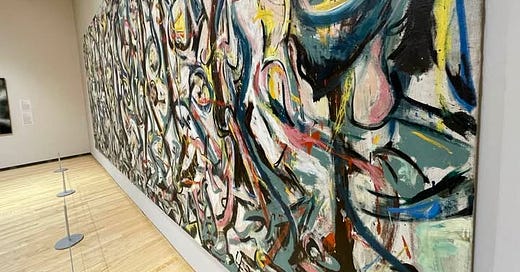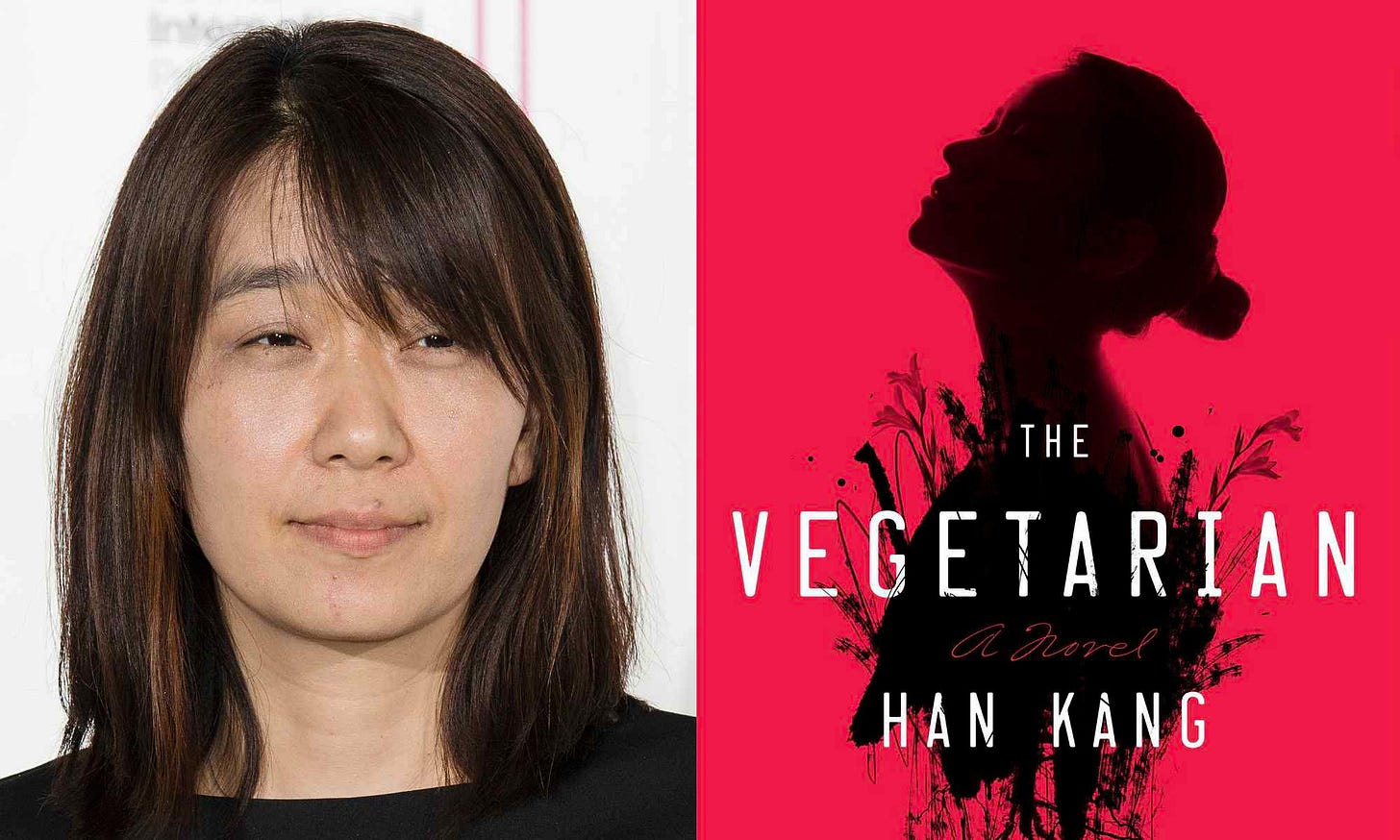Take Five: Art can change the world
In fact, at this point it might be the only thing we can count on that will, and Heather McGhee is a great place to start. Nobel Prizes, Jackson Pollock and some bright tunes round out the week
“Take Five” is posted each Friday, and offers five things I spent some time with over the course of the previous week. No criticism, no in-depth analysis, just a few things I think you might be interested in checking out. When the spirit moves me, I’ll post other things at other times.
OK, this starts heavy with some important things, and then, if you make it that far, a bit of whimsy. The country is crumbling, and elected officials in my state seem as if they are in a race to be sure our little corner of it is gone before the feds get around to finishing the job. The arts offer a respite, but also a way forward.
1. Heather McGhee — The Sum of Us
Sometimes art must find its moment. I read plenty of fawning reviews of Heather McGhee's The Sum of Us, and even had it suggested by my wife, but it wasn't until a month ago as the Trump Administration began to burn down everything good in our country that it felt necessary to move it from my “to be read” list to my nightstand. I'm glad I did. In it, McGhee writes about how the racism that has held back African Americans for so long is also doing significant damage to the majority white population, that removing these barriers will help everyone. I recall it was a recent recommendation from John Warner, who writes the great Biblioracle Substack (and covers books for the Chicago Tribune) that nudged me over the edge, though I can't find it to give credit.1 It's interesting to read this 2021 book in 2025. At its publication, it felt like things might finally be turning in the right direction with a push from the Black Lives Matter movement, but McGhee even then noted the backlash. I'm sure she could not have predicted just how forceful, vindictive, and punitive that response would eventually be. I would encourage everyone to read this book. It's a sobering look at the ways we have damaged our country, a prescriptive analysis of what it could mean if we turn it around, and an accounting of the hard work it will require.
Dr. King said that the arc of the moral universe is long, but it bends toward justice. But we know that progress is not guaranteed. When the arc in America bends from slavery in the 1860s and returns to convict leasing in the 1880s; when it bends from Jim Crow in the 1960s and returns to mass incarceration in the 1970s; when it bends from Indigenous genocide to an epidemic of Indigenous suicides, when it bends, but as a tree does in the wind, only to sway back, we have to admit that we have not touched the root.
2. Jackson Pollock — ‘Mural’
I was back in the University of Iowa's Stanley Museum of Art2 this week, and I took advantage by spending a bit more time with some favorites. It was a hell of a week, and a few moments sitting in front of Jackson Pollock's "Mural" was restorative. It's one of the most well-known paintings in the world, and it isn't lost on me how lucky I am to be able to walk a few blocks from my office and see it whenever I like. If it is possible for a 19-foot long canvas with a riot of poured and dripped paint filling every inch to become easy to take for granted, it is this. It is so ubiquitous here that you can forget how staggering an achievement it was back in 1943. I’ve had the idea of just exploring a 2x2 section every time I’m here, but it is too hard to maintain focus and my eye gets pulled across the massive expanse. This week, I found myself looking at a one color at a time — the slashes of black, then the blotches of yellow, then the swirls of pink, and so on, my eye extracting each as if it was a layer on a transparency. Then my eye caught on a small shape about two feet up almost dead center on the canvas that looks like a farm building seen from an airplane, a black line of shadow along the roofline as the sun falls on the lee side, a red and yellow glow falling across the shingles. Next time, it will be something else. I've probably spent a few hours cumulatively looking at the painting over the years, and will spend a few more if I'm lucky.
3. Han Kang — The Vegetarian
I picked up The Vegetarian by South Korean writer Han Kang because she was the first South Korean to win the Nobel Prize in Literature last fall and because she is a past participant in the International Writing Program at the University of Iowa. What I found was as expected — a remarkable, thought provoking work in translation. What I also found was a book that, if bills working their way through the Iowa Legislature this session are passed into law, would be illegal to shelve in a public library. That’s because it includes depictions of sex acts, integral to the story though they may be. One bill states, “[T]he librarian shall not select or make purchases of any materials with descriptions or visual depictions of a sex act.” No nuance, no context, no exception for artistic merit. It is a powerful, disturbing novel about South Korean etiquette, personal agency and family dynamics. It needs the scene in question because it deftly propels the dynamics of the story forward as the characters — and by extension, the reader — grapple with issues of violence, rigid tradition, and gender roles. Republicans in the Iowa Legislature don’t want you to read it, but I do, or rather, I want you to have the choice. That’s the point. You should be able to read it and the library should be able to make it a part of its collection. I wrote more about this here, and if you are here in Iowa, I urge you to let your legislators know you oppose these ridiculous, harmful, anti-library bills.
4. Ricky Albeck - ‘Insignificant Favours’
That’s all a little heavy, so how about a countryish rocker from Australian musician — who I can almost guarantee you’ve never heard of — Ricky Albeck. I read about Albeck months ago at Raven Sings the Blues, loved the sample track, and bought the ridiculously cheap album from whence it came. Then, it sat on my hard drive until this week, when I finally loaded it onto my phone and listened on the bus on my way to work. It’s a solid record, but that first song is a stunner. It seems to be a portrait of a cranky old man recounted conversationally over a loping, twangy tune chock full of weeping pedal steel guitar before it builds to the chorus:
Oh, goddamn
Keep askin’
Keep askin’
Albeck sings, and it’s the most majestic thing. It may be the storyteller or the old man himself talking, but whatever the source, it’s such a release, as if the entire week, the entire month-plus of awful can be kept at bay with one beautifully soaring curse3. I know I’ll wear the song out over the next week or two before moving on, only to rediscover it down the road again and again.
5. Beach Boys — ‘Let Him Run Wild’
My first major exposure to the Beach Boys came with the purchase of The Beach Boys Super Hits, a 1978 Ronco4 cash-in that I'm sure I picked up at a department store when on a shopping trip with my parents. It duplicates about two-thirds of 1974's commercial shot-in-the-arm Endless Summer, but it is what it leaves off that had an impact on my fandom. It wasn’t until a friend made a mixtape for me in the ‘90s that included “Let Him Run Wild” that I heard that track, and it helped to unlock a love for the orchestrations of Brian Wilson that continues to this day. Super Hits is even more focused on surfing and cars than Endless Summer, so that was my lens on the band until adulthood. Had I ponied up a couple more dollars for Endless Summer as a kid, I might have been much hipper (and happier) at an earlier age. I was reminded of this while listening to the Jokermen podcast’s recent conversation about Endless Summer, realizing I had missed out on standouts like “Girl Don’t Tell Me” and “The Warmth of the Sun” for 15 years or more because I was a frugal eight year old. But now I can listen to “Let Him Run Wild” whenever I want, and can revel in this stunningly arranged song from 23-year-old Wilson.

I did find a spirited endorsement for the book from Warner from 2021, before I discovered the Biblioracle, and if you haven’t been swayed by me, he should be able to close the deal.
A late addition to the “soaring curse” discourse, with the members of R.E.M. joining Jason Narducy and Michael Shannon on stage on Thursday in Athens to perform “Pretty Persuasion,” which has the even more appropriate to the times “God damn, pure confusion”that rings out in the chorus.
Another late addition (at some point this could be its own separate post) to the “Goddamn” chorus song list with “Nerves” from Silkworm’s 1996 album Firewater, a jumpy, angular tune with the memorable chorus of “Goddamn the circumstance that brought me here and goddamn you my friend.”
Ronco is a company that sells kitchen implements through infomercials, but in the ’70s and ’80s it also operated a record label that made K-tel seem lavish. It issued cheaply made hits collections like this on vinyl and 8-track and… wow, am I dating myself here.






